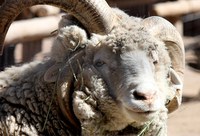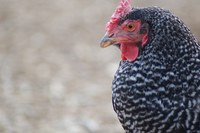Heritage Breeds at the Farm
At the Heritage Farm, we exhibit and teach about the importance of heritage animals and heirloom variety plants. Like endangered species at the zoo and aquarium, some of these heritage breeds are threatened with extinction, or recovering from that threat.
Navajo-Churro Sheep
 The Navajo-Churro sheep are one such breed that is protected under the Livestock Conservancy registry of endangered breeds. Navajo-Churro were brought to the southwestern United States by the Spanish in the 1540’s. This breed was abundant in the Southwest from the late 1500’s until the mid 1800s. They were hearty, adaptable and used for meat and textiles. By the 1930s there were very few herds of this distinctive breed, due to the US Governments efforts to curtail rangeland erosion problems and subjugate the tribes of the Southwest. Efforts to recover the breed have been in place since 1977. You can see two Navajo-Churro ewes at the exhibit’s animal barn.
The Navajo-Churro sheep are one such breed that is protected under the Livestock Conservancy registry of endangered breeds. Navajo-Churro were brought to the southwestern United States by the Spanish in the 1540’s. This breed was abundant in the Southwest from the late 1500’s until the mid 1800s. They were hearty, adaptable and used for meat and textiles. By the 1930s there were very few herds of this distinctive breed, due to the US Governments efforts to curtail rangeland erosion problems and subjugate the tribes of the Southwest. Efforts to recover the breed have been in place since 1977. You can see two Navajo-Churro ewes at the exhibit’s animal barn.

Milking Shorthorn
Rocky, the steer out at the farm is a milking shorthorn, one of the most critically endangered cattle breeds in the United States. They are originally from Durham, England. An incredibly popular breed for quality milk production and meat for hundreds of years (introduced in the United States in the 1780s), milking shorthorns were replaced by Holstein’s which produce more but less–tasty milk.
Dominique Chickens
 The black and white barred Dominique chickens have a great conservation story as America’s first chicken breed. Dominiques nearly disappeared in the 1970s. Only four known flocks existed when major efforts went into preserving the unique breed. Today, these chickens are still on the Conservation Priority List, but are much recovered from their decline 40 years ago.
The black and white barred Dominique chickens have a great conservation story as America’s first chicken breed. Dominiques nearly disappeared in the 1970s. Only four known flocks existed when major efforts went into preserving the unique breed. Today, these chickens are still on the Conservation Priority List, but are much recovered from their decline 40 years ago.
Livestock Facing Extinction
Twenty one percent of the world’s 8000 breeds are in danger of extinction. The Livestock Conservancy works to protect the genetic diversity of our global livestock and poultry breeds organization through education, outreach, research, and even genetic material rescues.
Why should we care about these breeds?
We need heritage breeds (like we need diverse plant varieties) to protect our agricultural assets around the world! Protecting diversity–-the variety of life at all levels–-helps us to make sure that we don’t loose access to unique characteristics or adaptations that might make a breed more beneficial to us in the future.
Diversity also helps to prevent catastrophic events from having a domino effect, like the potato blight that caused the Irish Potato Famine of the 1800s. Additionally, diversity keeps things interesting and many of the breeds that have fallen out of favor today, have long and fascinating stories that connect us to our past.
Heritage Crops
Open pollinated and passed through generations, heritage crops were produced on a small scale by people who lived off the land. Now, after a shift to large-scale agriculture, many of those crops are on the brink of disappearing. Learn more about the Heritage Farm's heritage crops.
